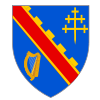St Patrick's Cathedral, Armagh (Church of Ireland)
| The Cathedral Church of St. Patrick, Armagh | |
|---|---|
| Cathedral of the Diocese of Armagh and Metropolitan Cathedral of the United Provinces of Armagh and Tuam | |
 | |
| 54°20′52″N 6°39′23″W / 54.347811°N 6.656277°WCoordinates: 54°20′52″N 6°39′23″W / 54.347811°N 6.656277°W | |
| Country | United Kingdom — Northern Ireland |
| Denomination | Church of Ireland |
| Website | www.stpatricks-cathedral.org |
| History | |
| Founded | AD 445 |
| Founder(s) | Saint Patrick |
| Dedication | St Patrick |
| Consecrated | AD 445 |
| Administration | |
| Diocese | Diocese of Armagh |
| Province | Province of Armagh |
| Clergy | |
| Archbishop | The Most Reverend Richard Clarke |
| Dean | The Very Reverend Gregory Dunstan |
| Precentor | The Reverend Terence Cadden |
| Chancellor | The Reverend Canon Colin Moore |
| Archdeacon | The Venerable Raymond Hoey |
| Laity | |
| Organist(s) | Theo Saunders |
St Patrick's Cathedral, Armagh is the seat of the Archbishop of Armagh in the Church of Ireland. It is found in Armagh, Northern Ireland. It is also the cathedral of the Diocese of Armagh.
History
The origins of the cathedral are related to the construction in 445 of stone church on the Druim Saileach (Willow Ridge) hill by St. Patrick, around which a monastic community developed. The church was and is the centre of the Church of Ireland. Following the Henrician Reformation in Ireland the cathedral became increasingly associated with the then Established Church and has been definitively in Anglican hands since the reign of Elizabeth I. A Roman Catholic cathedral was built on a neighbouring hill in the nineteenth century. Cordial relations exist between both cathedrals.
The church itself has been destroyed and rebuilt 17 times. The edifice was renovated and restored under Dean Eoghan McCawell (1505-1549) at the start of the sixteenth century having suffered from a devastating fire in 1511 and being in poor shape. Soon after his death the cathedral was described by Lord Chancellor Cusack as ‘one of the fairest and best churches in Ireland’.[1] Again it was substantially restored between 1834 and 1840 by Archbishop Lord John George Beresford and the architect Lewis Nockalls Cottingham. The fabric remains that of the mediaeval (and earlier – in particular the crypt ) buildings but much restored. While Cottingham was heavy-handed in his restoration the researches of T. G. F. Patterson and Janet Myles in the late twentieth century have shown the restoration to have been notably antiquarian for its time. The tracery of the nave windows in particular are careful restorations as is the copy of the font. The capital decoration of the two western most pillars of the nave (either side of the West Door internal porch) are mediaeval as are the bulk of the external gargoyle carvings (some resited) of the parapet of the Eastern Arm. Cottingham's intention of retaining the richly cusped West Door with flanking canopied niches was over-ruled. Subsequent restorations have more radically altered the internal proportions of the mediaeval building, proportions which Cottingham had retained.
Many other Celtic and mediaeval carvings are to be seen within the cathedral which is also rich in eighteenth and nineteenth century sculpture. There are works by Chantry, Roubiliac, Rysbrack, Mirochetti and others.
The Cathedral Foundation and Worship Precentor – The Reverend Terence Scott; Chancellor – The Reverend Colin Moore; Treasurer – The Reverend John McKegney; Archdeacon – The Venerable Raymond Hoey. Prebendaries: Mullabrack, The Reverend W J A Dawson (2006) Ballymore, The Reverend R J N Porteus (2006) Loughgall, The Reverend J N T Campbell (2009) Tynan, The Reverend W M Adair
Priest Vicars Choral: The Reverend Peter Thompson, Succentor (2006) The Reverend Michael Kennedy (1995) The Reverend T A Cross (2006) The Reverend E M Culbertson (2007) The Reverend J Moore (2007) The Reverend J M McClenaghan (2007)
The Choral Foundation, dating from the Culdees, and refounded as the Royal College of King Charles of Vicars Choral and Organist in the cathedral of Armagh, continues to the present. There are generally a dozen Gentlemen of the Lay Vicars Choral and sixteen boy choristers.
Each Sundays there are three services in the cathedral; 10 am said Eucharist, 11 am Sung Eucharist (except on the second Sunday of the month when Matins is sung) and 3:15 pm Choral Evensong. Matins is said, Mondays to Saturdays, at 9:30 am. On holy days and feast days, the Eucharist is celebrated at 9:30 am.
Notable burials
- Marcus Gervais Beresford (1801–85), Archbishop of Armagh and Primate of All Ireland (appointed 1862). Cousin of Lord John Beresford
- Charles Frederick D'Arcy (1859–1938), Archbishop of Armagh and Primate of All Ireland
- Saint Ethnea, baptised by St. Patrick, died around 433 A.D.; her Feast Day is 11 January
- Brian Boru (c.942–1014) High King of Ireland
- Lord John Beresford
- John Baptist Crozier and his wife Alice Isabella
Organists
|
|
|
See also
- Dean of Armagh, a list of Deans
- List of cathedrals in Ireland
- St Patrick's Cathedral, Armagh (Roman Catholic)
| Wikimedia Commons has media related to St Patrick's (COI) Cathedral, Armagh. |
References
- ↑ The Church Among Two Nations. Published in Early Modern History (1500–1700), Features, Issue 1 (Spring 1998), Medieval History (pre-1500), Volume 6 http://www.historyireland.com/early-modern-history-1500-1700/the-church-among-two-nations/
